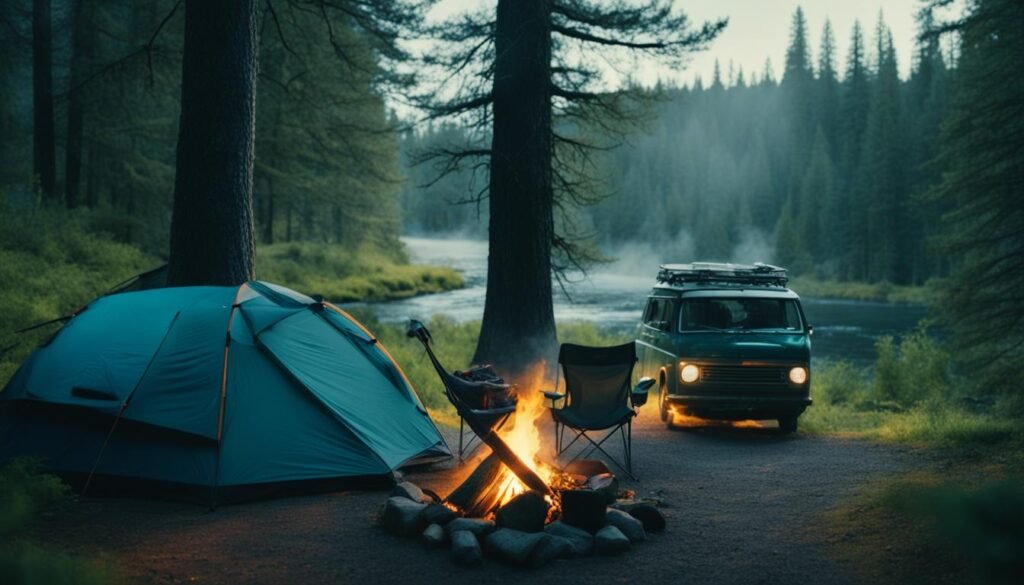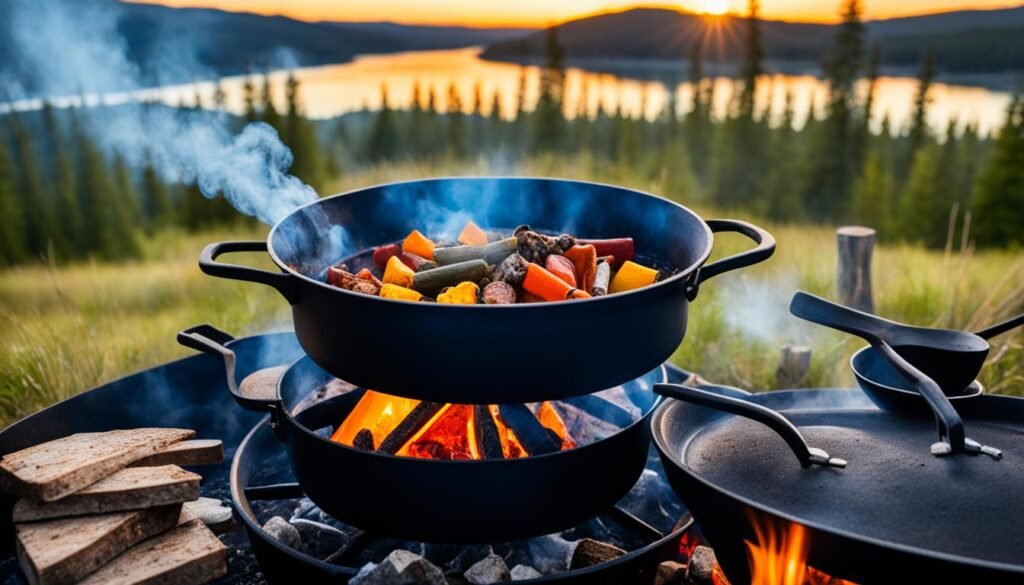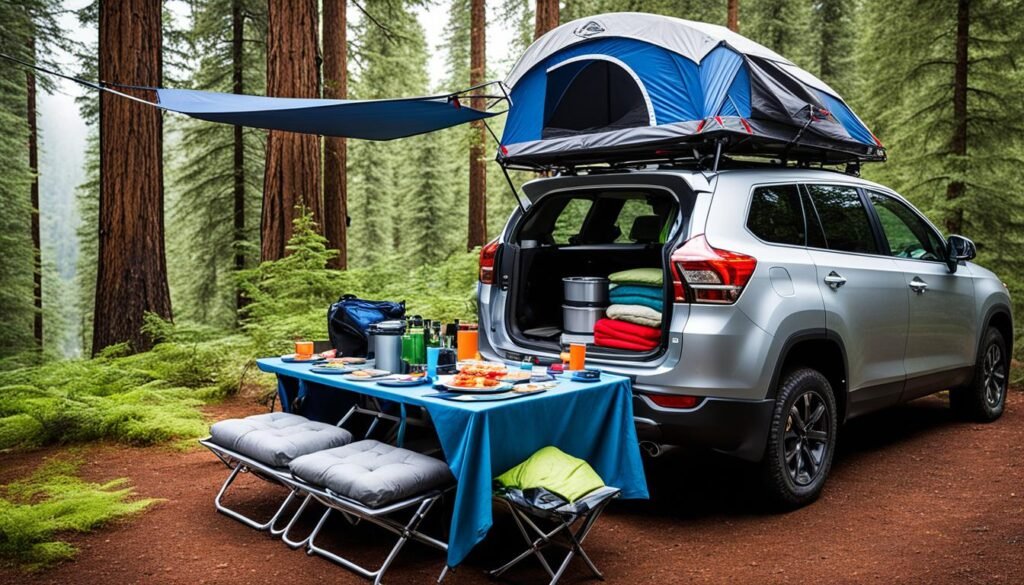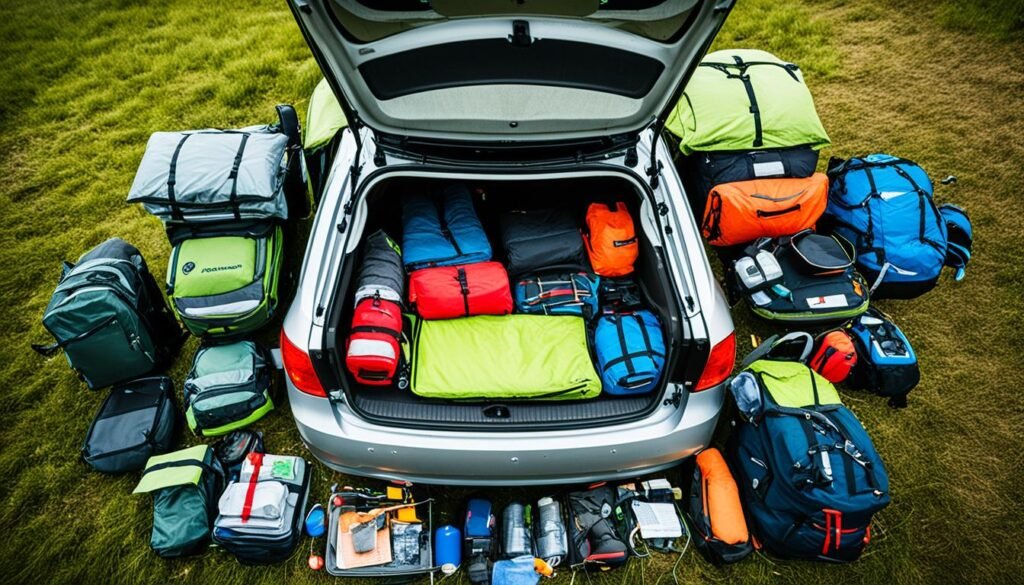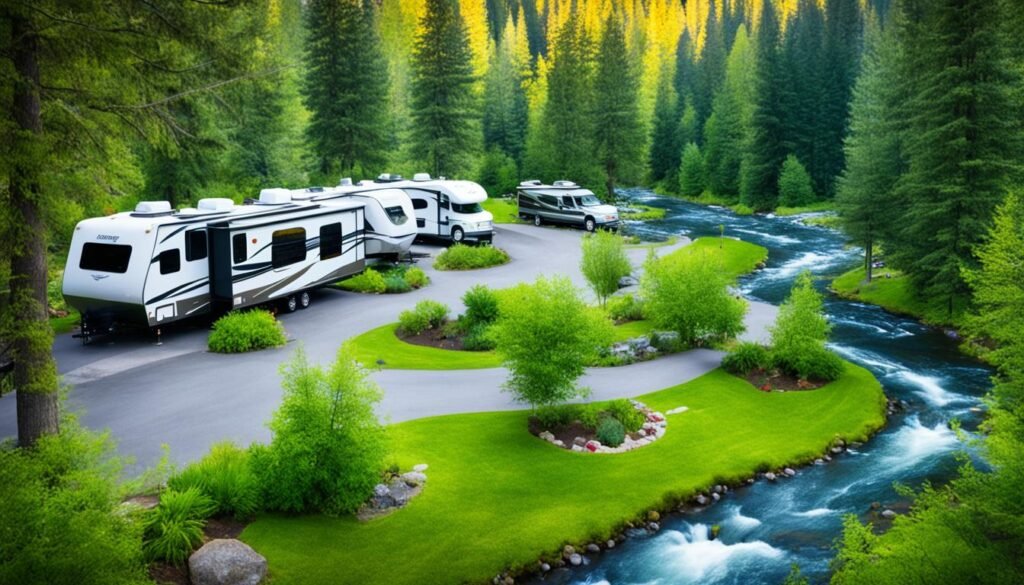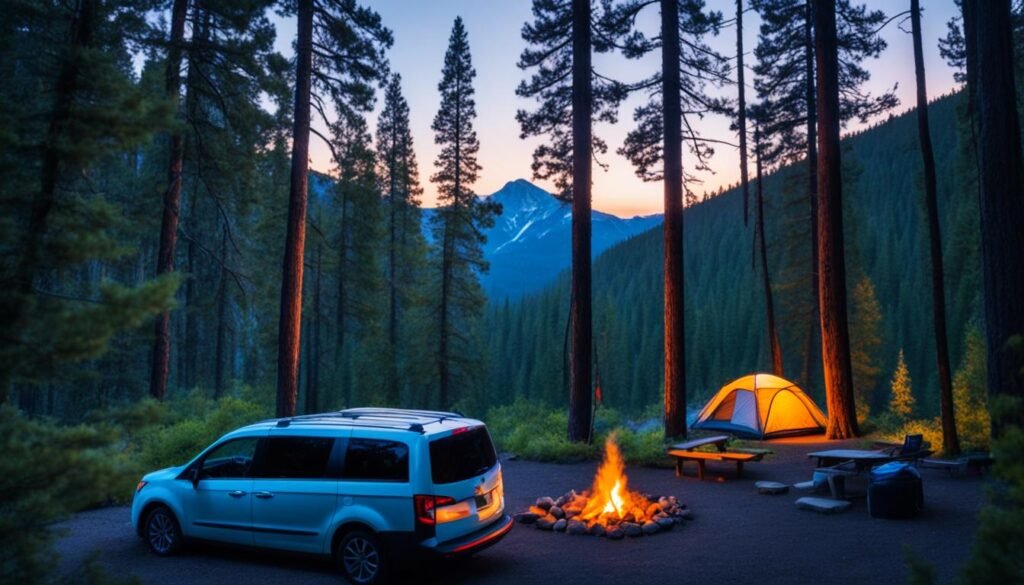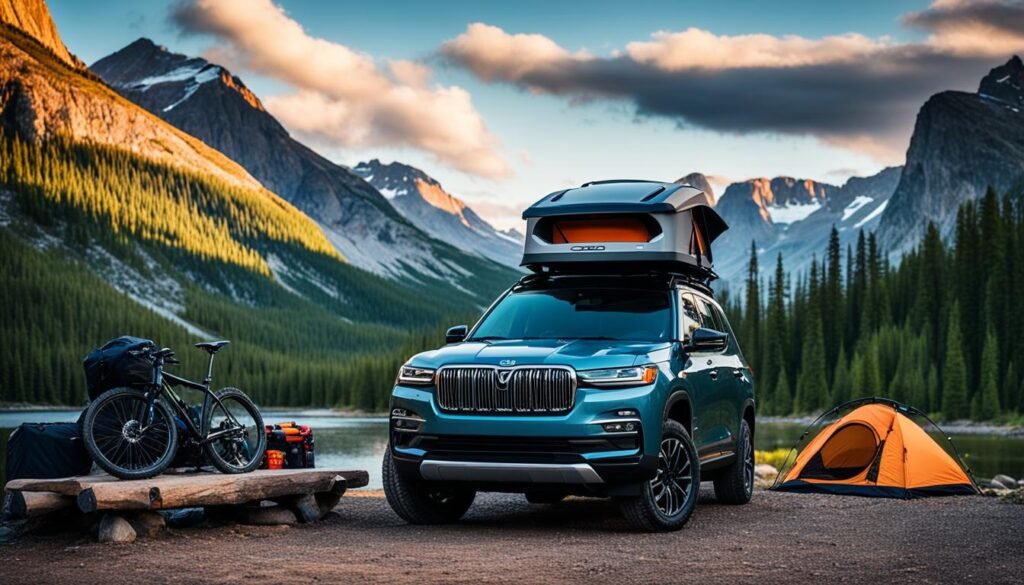Car camping can be a great way to explore the outdoors and experience the freedom of sleeping in your vehicle. However, it’s important to understand where you can legally and safely car camp. In California, it is generally legal to sleep in your car on public property, such as city streets, as long as you are not violating any parking regulations or prohibitions on overnight camping.
Sleeping in a car on private property, like a parking lot, would require permission from the property owner. It is illegal to sleep in your car on freeways or highways. Different areas may have their own regulations and restrictions, so it’s important to research and be aware of the specific rules before car camping in any location.
Key Takeaways:
- Car camping allows for outdoor exploration and the freedom of sleeping in your vehicle.
- In California, car camping is generally allowed on public property, but specific rules and regulations vary by location.
- Sleeping in a car on private property requires permission from the owner.
- It is illegal to sleep in your car on freeways or highways.
- Research and understanding of regulations are essential before car camping in any area.
Where Can You Sleep in Your Car in California?
In California, there are various options for sleeping in your car legally. One popular choice is to sleep in campgrounds, either at state parks or national forests. Campgrounds provide designated areas with amenities such as restrooms, fire rings, and sometimes showers. Another option is to participate in dispersed camping in national forests, where you can camp anywhere outside of established campgrounds. Dispersed camping offers more freedom and solitude but may lack amenities. Additionally, some people choose to sleep in the parking lots of certain businesses like Walmart or Planet Fitness. However, availability and rules for sleeping in these lots can vary. It’s important to research and plan accordingly to find the best and safest car camping options in California.
- Sleeping in campgrounds at state parks or national forests
- Participating in dispersed camping in national forests
- Sleeping in the parking lots of certain businesses like Walmart or Planet Fitness
Considerations for Car Camping in California:
- Research and understand the rules and regulations for each location
- Respect private property and seek permission when necessary
- Plan ahead and be prepared with necessary supplies and equipment
- Keep safety in mind and be aware of your surroundings
- Practice Leave No Trace principles and leave the area as you found it
Sleeping in your car can be a convenient and affordable way to enjoy the beauty of California’s landscapes. Whether you choose to sleep in designated campgrounds, participate in dispersed camping, or explore alternative options, make sure to prioritize safety, respect the rules and regulations, and leave a minimal impact on the environment.
Best Areas in California to Car Camp
California offers a variety of beautiful locations for car camping. Whether you prefer the stunning beaches of Southern California, the breathtaking coastal views of Central California, or the majestic redwood forests of Northern California, there are car camping options that cater to every adventurer’s desires.
Southern California
If you’re looking for car camping locations in Southern California, you’ll be spoilt for choice. Here are some popular spots:
- San Elijo State Beach Campground
- Point Mugu State Park Campgrounds
- Leo Carrillo State Park
- Silver Strand State Beach
- San Onofre State Beach
Central California
Central California offers a diverse range of car camping locations. Consider these options for an unforgettable experience:
- Oceano Dunes Campground
- Pfeiffer Big Sur State Park
- Andrew Molera State Park
- San Simeon Creek Campsite
Northern California
For car camping enthusiasts, Northern California boasts some of the most picturesque camping sites in the state. Discover the wonders of nature at these locations:
- Jedediah Smith Redwoods State Park
- Sequoia and Kings Canyon National Parks
- Yosemite National Park
Each region has its own unique landscapes and attractions, providing plenty of options for memorable car camping experiences. Whether you’re seeking sandy beaches, towering redwoods, or breathtaking mountain vistas, California has it all.
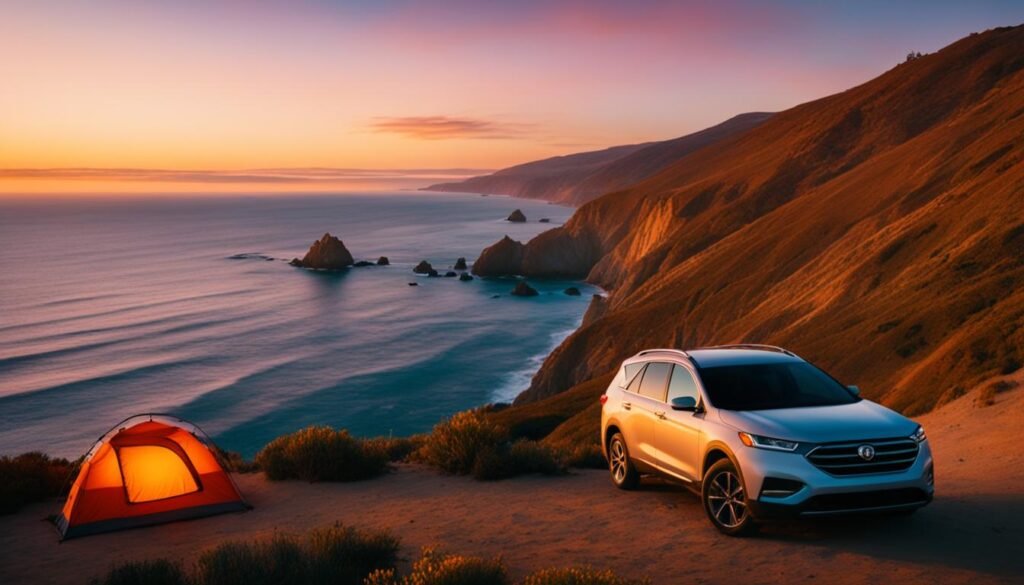
Dispersed Camping in California
Dispersed camping, also known as boondocking or wild camping, is a popular way to explore the great outdoors in California. This type of camping allows you to set up camp outside of designated campgrounds, providing a more secluded and off-the-grid experience. Unlike traditional campgrounds, dispersed camping sites don’t offer amenities like restrooms or running water. However, they offer unmatched privacy, seclusion, and the opportunity to immerse yourself in the untouched beauty of California’s landscapes.
California is home to vast areas of public lands managed by the Bureau of Land Management (BLM) and national forests, which provide ample opportunities for dispersed camping. The BLM public lands offer numerous dispersed camping sites, where campers can stay for up to 14 days. These sites are typically located in remote and picturesque locations, allowing campers to fully embrace the wildness of nature. National forests in California also permit dispersed camping, with campsites located off service roads, away from the hustle and bustle of established campgrounds.
While dispersed camping may lack certain amenities, it presents an excellent opportunity for those seeking solitude, tranquility, and a deeper connection with the natural surroundings. With careful planning and preparation, including packing adequate supplies and practicing Leave No Trace principles, dispersed camping in California can be a rewarding and memorable experience.
To give you a better idea of what to expect, here are some key aspects of dispersed camping in California:
- Privacy and seclusion: Dispersed camping allows you to escape the crowds and enjoy the serenity of nature without the usual distractions. You’ll have more privacy, with campsites often spread out and surrounded by breathtaking scenery.
- Unspoiled landscapes: By camping in remote areas, you’ll have the chance to explore untouched landscapes and witness the raw beauty of California’s wilderness. Whether it’s towering mountains, pristine lakes, or majestic forests, dispersed camping offers a front-row seat to nature’s wonders.
- Self-sufficiency: Dispersed camping requires self-sufficiency as you won’t have access to amenities like restrooms or running water. You’ll need to bring your own supplies, including food, water, and sanitation equipment. It’s essential to be prepared and practice responsible camping to minimize your impact on the environment.
The Bureau of Land Management (BLM) Dispersed Camping Sites
The Bureau of Land Management (BLM) manages extensive public lands in California, providing numerous dispersed camping opportunities. These sites are spread throughout the state, offering a wide range of landscapes and environments to explore. Some popular BLM dispersed camping sites in California include:
| Name of BLM Dispersed Camping Site | Location |
|---|---|
| Owens Valley | Eastern Sierra region |
| Clear Creek Management Area | Central California |
| King Range National Conservation Area | North Coast |
These are just a few examples of the BLM dispersed camping sites in California. Each site offers unique opportunities for outdoor enthusiasts to experience the rugged beauty of the state.
Dispersed Camping in National Forests
California’s national forests also provide excellent opportunities for dispersed camping. These forests offer vast areas of public land where campers can set up camp away from established campgrounds. Some popular national forests in California for dispersed camping include:
- Los Padres National Forest
- Mendocino National Forest
- Lassen National Forest
These national forests offer a range of landscapes, from towering redwoods to snow-capped mountains, providing diverse options for dispersed camping in California.
When opting for dispersed camping in California, it’s crucial to check for any specific regulations or permits required by the BLM or national forest you plan to visit. Familiarize yourself with the rules and guidelines to ensure a safe and enjoyable camping experience.
Overall, dispersed camping offers a unique way to explore California’s natural beauty and connect with the outdoors in a more intimate and secluded setting. It is a fantastic option for those seeking adventure, solitude, and a break from the confines of traditional campgrounds.
Camping Restrictions and Prohibitions
While there are many places where you can camp in California, it is important to be aware of the camping restrictions and prohibitions that exist. Understanding and respecting these boundaries and regulations is crucial for camping legally and responsibly. Here are some key restrictions and prohibitions to keep in mind:
Private Land
It is prohibited to camp on private land without obtaining permission from the owner. Always ensure you have the proper authorization before setting up camp on private property.
Business Parking Lots
Many private businesses do not permit overnight camping in their parking lots. Although some may make exceptions, it is advisable to seek alternative camping areas to avoid any potential issues. Respect the policies and preferences of businesses regarding overnight stays.
Highway Rest Areas
Rest areas along highways are designed for short breaks and rest periods, and overnight camping is typically not allowed. These areas have specific regulations in place to ensure their intended purpose is served. Plan your camping destinations accordingly to adhere to these restrictions and find appropriate campgrounds or dispersed camping areas.
Remember, it’s important to respect these camping restrictions and prohibitions to ensure a positive camping experience for yourself and others.
To help you better navigate the camping regulations in California, here is a visually engaging and informative table summarizing the key restrictions and prohibitions:
| Restriction/Prohibition | Explanation |
|---|---|
| Private Land Camping | Camping without permission from the landowner is prohibited. |
| Business Parking Lots | Many businesses do not allow overnight camping in their parking lots. Exceptions may exist but it is advisable to seek alternative camping areas. |
| Highway Rest Areas | Camping is not allowed in rest areas along highways, which are designed for short breaks and rest, not overnight stays. |
By adhering to these restrictions and finding appropriate camping areas, you can ensure a legal and enjoyable camping experience in California.
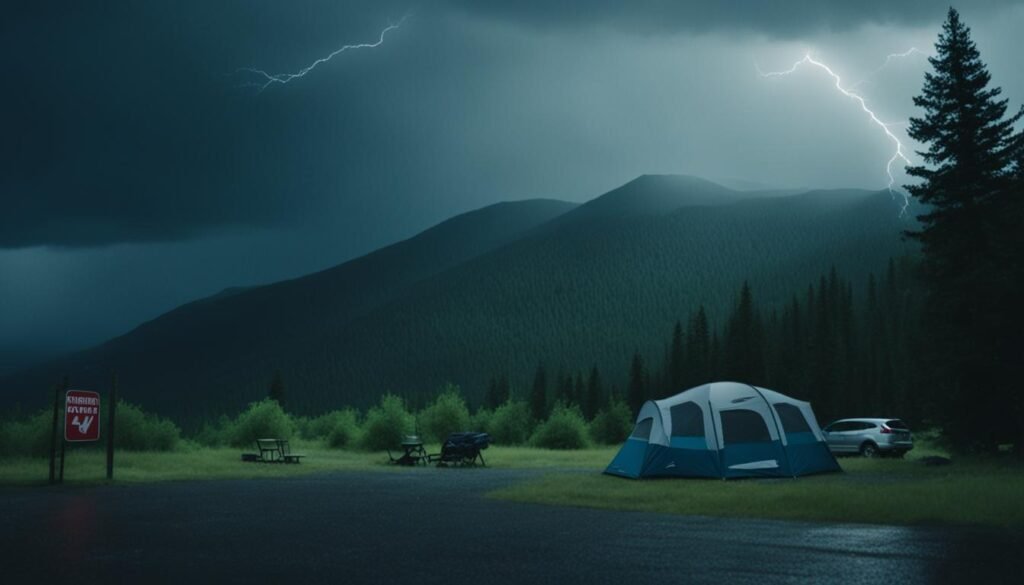
Differences Between Dispersed Camping and Designated Campgrounds
When it comes to camping experiences, there are distinct differences between dispersed camping and designated campgrounds. Each option offers its own set of benefits and considerations that cater to different camper preferences. Let’s take a closer look at what sets them apart:
Dispersed Camping
Dispersed camping, also known as boon docking or wild camping, allows campers to venture off the beaten path and set up camp outside of designated campgrounds. This type of camping is typically found in national forests, BLM (Bureau of Land Management) public lands, and other remote areas.
Benefits of dispersed camping include:
- Seclusion and privacy: Dispersed campgrounds are often more secluded, providing a greater sense of solitude and tranquility.
- Flexibility: With no reservations or assigned campsites, you have the freedom to choose where and when to camp, allowing for a more spontaneous adventure.
- Closer to nature: Dispersed camping allows you to immerse yourself in the natural surroundings, offering a more immersive wilderness experience.
It’s important to note that dispersed camping typically lacks amenities such as picnic tables, fire pits, restrooms, and running water. Campers need to be self-sufficient and come prepared with their own camping equipment, food, and water.
Designated Campgrounds
Designated campgrounds are established camping areas that provide amenities and facilities to enhance the camping experience. These campgrounds can be found in national parks, state parks, and private campgrounds.
Benefits of designated campgrounds include:
- Amenities and convenience: Designated campgrounds often offer amenities such as picnic tables, fire pits, restrooms, and sometimes even showers, providing convenience and comfort during your camping trip.
- Community and social interaction: These campgrounds are usually closer to other campers, allowing you to connect with fellow outdoor enthusiasts and share experiences.
- Reservations and organization: Many designated campgrounds require reservations, ensuring you have a guaranteed spot and minimizing the risk of arriving at a full campground. They also provide clearly marked campsites for easy setup.
While designated campgrounds offer more amenities and a structured camping experience, they may have limited availability and require fees or permits for camping. Additionally, the proximity to other campers may result in less privacy and a more crowded camping environment.
Ultimately, the choice between dispersed camping and designated campgrounds depends on your personal preferences, the level of solitude you seek, and the desired camping experience. Some campers thrive in secluded wilderness, while others prefer the convenience and amenities provided by designated campgrounds.
As you embark on your next camping adventure, consider the benefits of each camping style and choose the option that aligns best with your outdoor aspirations and comfort level. Remember to always be prepared, follow local regulations, and practice Leave No Trace principles to ensure a respectful and sustainable camping experience in California’s beautiful landscapes.
Conclusion
Car camping offers a unique and adventurous way to embrace the great outdoors and experience the freedom of sleeping in your vehicle. Whether you prefer the convenience of designated campgrounds, the solitude of dispersed camping, or the flexibility of alternative options like sleeping in parking lots, it’s essential to conduct thorough research and familiarize yourself with the regulations and restrictions of each location.
To ensure a positive and sustainable car camping experience, it’s crucial to respect private property, abide by the rules and regulations set forth by authorities, and practice Leave No Trace principles. By minimizing our impact and preserving the natural environment, we can continue to enjoy the beauty of California’s landscapes for years to come.
As with any outdoor activity, careful planning and preparation are key to a successful car camping trip. Consider packing essential gear, such as a comfortable sleeping pad, warm sleeping bag, cooking utensils, and safety equipment. Familiarize yourself with the weather conditions, wildlife, and potential hazards of the area you plan to explore. Additionally, be mindful of fire safety, waste management, and personal safety throughout your car camping journey.
So, whether you embark on a rugged adventure in the wilderness or opt for a more established campsite, car camping offers endless possibilities for connecting with nature, creating lasting memories, and discovering the hidden gems of California. With the right mindset and a spirit of exploration, you’re bound to have a remarkable car camping experience that will leave you yearning for more outdoor adventures. Happy car camping!
FAQ
Can I car camp anywhere?
Car camping is generally legal on public property, such as city streets, as long as you are not violating parking regulations or prohibitions on overnight camping. However, it is important to research and be aware of specific rules and regulations in each area before car camping.
Where can I sleep in my car in California?
In California, you can sleep in campgrounds, either at state parks or national forests. You can also participate in dispersed camping in national forests. Some people choose to sleep in the parking lots of businesses like Walmart or Planet Fitness, although rules and availability may vary.
What are the best areas in California to car camp?
In Southern California, popular car camping spots include San Elijo State Beach Campground, Point Mugu State Park Campgrounds, Leo Carrillo State Park, Silver Strand State Beach, and San Onofre State Beach. In Central California, options include Oceano Dunes Campground, Pfeiffer Big Sur State Park, Andrew Molera State Park, and San Simeon Creek Campsite. Northern California offers campsites in Jedediah Smith Redwoods State Park, Sequoia and Kings Canyon National Parks, and Yosemite National Park.
What is dispersed camping in California?
Dispersed camping, also known as boondocking or wild camping, is the practice of camping outside of designated campgrounds. In California, dispersed camping is available on public lands managed by the Bureau of Land Management (BLM) and national forests. It offers a more self-sufficient camping experience but lacks amenities like restrooms and running water.
Are there any restrictions on camping in California?
Yes, there are restrictions on camping in California. Camping is not allowed on private land without permission from the owner. Many businesses do not allow overnight camping in their parking lots. Rest areas along highways do not permit camping. It is important to respect these restrictions and seek out appropriate camping areas.
What are the differences between dispersed camping and designated campgrounds?
Designated campgrounds provide amenities like restrooms, picnic tables, and fire pits. They are closer to other campers and often require reservations and fees. Dispersed camping does not have these amenities and offers a more secluded experience. It requires careful planning and preparation.
Any final thoughts on car camping?
Car camping can be a wonderful adventure that allows you to connect with nature and enjoy the beauty of California’s landscapes. Research and understand the regulations and restrictions of each location, respect private property, follow rules and regulations, and practice Leave No Trace principles for a positive and sustainable car camping experience.

